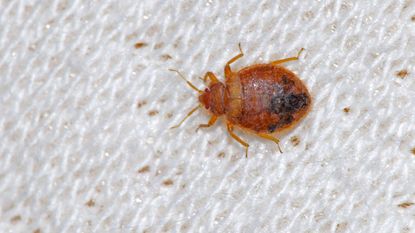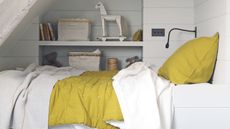How to get rid of bed bugs – banish these invaders from your home
Need to know how to get rid of bed bugs? Find out how to eject these pests from the professionals

Discovering you have pests in your home can be a shock and you’ll want to know how to get rid of bed bugs if they’ve taken up residence. These small insects often live on furniture or bedding and can leave red, itchy welts all over your body if you get an infestation.
Try not to despair, though, because although the bites can be irritating and unsightly, bed bugs are generally harmless and not thought to transmit disease. The downside is that it’s not as easy as getting rid of fruit flies or getting rid of gnats and it might just take some time, effort and patience to rid your home of these creepy-crawlies completely.
Here, we’ve put together all you need to know about identifying these pests and, most importantly, how to get rid of bed bugs from your home with advice from the professionals.
How to get rid of bed bugs
Be aware that getting rid of bed bugs is not as simple as getting rid of cockroaches. ‘Bed bugs are notorious for their resistance to treatment,’ says Jordan. ‘Commercial products will only push them into hiding, where they will continue to grow in number and the infestation will become worse without you even knowing.’
For successful eradication of bed bugs, follow these steps.
1. Identify the infested area
If you’ve got bed bugs, the key is to act quickly to try to contain the spread before they are given time to reproduce and create a bigger, more problematic infestation. You can search for bed bugs yourself, but you will need to be thorough as these small, narrow pests can fit into tiny spaces.
A torch and magnifying glass will help in darker, more confined areas of the home. ‘Bed bugs are very capable of squeezing themselves into small gaps around bed frames, outlets, couches, furniture and underneath wallpaper,’ says Sophie Thorogood, part of the technical team at Green Protect, which specializes in effective and sustainable solutions for a pest-free home.
‘Look carefully around these areas for signs of bed bugs including black spots which are the bed bugs’ feces, found on furniture surfaces and mattresses. A good inspection can indicate if you do have a problem and the extent of the infestation.’
Don’t forget to look in the frame of a bed, between couch cushions, furniture joints, underneath paintings and posters on the walls and in the seam where the wallpaper and ceiling meet.
2. Call in the experts
Once you have identified bed bugs, there are several steps (detailed below) that you can take to rid your home of these pests such as vacuuming, cleaning and various treatments. However, bed bugs are particularly problematic and notoriously difficult to get rid of, so some experts would recommend calling in pest control professionals straight away.
‘If you think there may be an infestation of bed bugs at your property, you should contact a pest control expert or your local council,’ says Robert Collins at MyJobQuote. ‘It can be very difficult to get rid of bed bugs as a DIY job as they can be difficult to locate and they’re often resistant to many insecticides.’
3. Vacuum immediately and thoroughly
To trap them and rid your home of bed bugs, your first job should be to use the best vacuum everywhere – that includes carpets and any other hiding places including the bed, under furniture, in the closet and any other dark crevices and corners. Before you vacuum your mattress, use a stiff brush to scrub mattress seams to remove bed bugs and their eggs.
‘The best way to approach a bed bug infestation is to start with decluttering tips and cleaning of the infested area,’ says Jordan Foster of Fantastic Pest Control. ‘Vacuum your bed and the surrounding area, then place the vacuum cleaner bag in a plastic bag and throw in the garbage bin.’
4. Wash at high temperatures or freeze
To kill bed bugs without using chemicals, high heat or freezing temperatures is a really effective method. Wash bed sheets and other affected bedding, clothing and curtains in a hot wash (at least 60ºC) and then tumble dry on a hot setting.
‘Remove all covers and bedding, empty all closets and wash everything at the highest temperature permissible,’ adds Jordan Foster. ‘Removing any carpets from the under the infested furniture will be helpful as well. The main goal here is to restrict the bed bugs from going to other parts of your property.’
Another option is to place the affected clothing and bedding in a plastic bag, then put this in the freezer for around three to four days.
5. Dry clean delicate fabrics or steam
For delicate fabrics that are infested, check the laundry symbols. A hot wash might not be possible and upholstery and clothing made out of wool and silk are in danger of shrinking and getting ruined. The best option here is dry cleaning.
‘Dry cleaning kills bed bugs at all life stages and is best for delicate fabrics and temperature-sensitive materials,’ says Fantastic Pest Control’s Jordan Foster.
Steaming is another good option for a mattress, couch and other awkward places where bed bugs hide. Run the best steam cleaner on the highest possible setting along furniture, paying special attention to the joints and all nooks and crannies.
‘Steaming furniture will kill bed bugs if in direct contact, so this can be useful for soft furnishings that are not washable,’ says Sophie Thorogood at Green Protect.
6. Buy a mattress cover
After cleaning and removing all visible bed bugs, invest in a tightly woven, zippered mattress cover to keep bed bugs from entering or escaping. Bugs that are trapped inside will die (and not be able to bite you) while new bugs will be prevented from getting in. Remember though, bed bugs may live for months without feeding so keep the mattress cover on for at least a year to make sure the infestation is totally gone. Note that it may be possible to wash a mattress cover or clean it in another way.
‘Invest in mattress covers that will protect the mattress from bed bugs getting to it and hiding in the seams, zippers etc,’ adds Jordan Foster. ‘These covers will also work to keep the bedbugs from escaping and biting you.’
If your mattress is infested, you may want to get a new best mattress – take care disposing of the old one and ensure the rest of your house is bed bug-free first, otherwise the bugs will simply take over your new purchase and have a new home.
7. Use a chemical treatment
If you’ve tried all of these methods to rid your home of bed bugs but the problem persists, the next step might be to use a chemical insecticide. Look for products that are specifically designed for use on bed bugs but be extra careful in the bedroom as some insecticides are harmful if not used properly. Mattresses and bed linens shouldn’t be treated with chemicals unless the label says so. Heard baking soda is the solution? The professionals say that the answer to can baking soda kill bed bugs is no.
Generally, if you are choosing to go down the chemical route for bed bug extermination, get in touch with an expert pest control company who will be able to carry out the job safely and efficiently. It will also have access to more powerful chemicals and other treatments such as whole room fogging and fumigation. You will probably need to stay out of the infested rooms for a few hours while the treatments do their work. Professional treatments take two to three visits to start working.
8. Prevent another bed bug infestation
It might take some time to get rid of bed bugs, but when you do, the key is to prevent future infestations. There are some easy steps you can take such as washing and vacuuming your bedding, furniture and carpets regularly. Organize a bedroom and avoid clutter around the bed and get rid of piles of papers, magazines, books and clothes littering the floor. Seal or tape over cracks around light sockets, glue down loose wallpaper and caulk cracks in furniture. Another tip is to slightly move your bed frame and headboard away from the wall, making it harder for bed bugs to climb on.
‘Bed bugs tend to enter homes through luggage and furniture,’ says Green Protect’s Sophie Thorogood. ‘To prevent the pests from entering your home, if you’re away on a trip, don’t place your luggage immediately on bedroom furniture. Instead, use the luggage racks with metal legs as bed bugs are unable to climb this. When returning home, wash your clothes immediately at a high temperature or dry clean them.’
Placing sticky traps around the legs of bedroom furniture will stop bed bugs climbing up into your bed – check and renew these devices regularly, for a full year.
What instantly kills bed bugs?
The high temperature of steam (212°F or 100ºC) will immediately kill bed bugs. Try a handheld steamer and apply steam to all your home’s hard-to-reach places such as the folds and tufts of mattresses, sofa seams, bed frames and corners, edges and cracks where bed bugs may be hiding.
Steaming clothes is a great idea too if delicate fabrics can’t be laundered at high temperatures in a washing machine and tumble drier.
Do bed bugs go away on their own?
Bed bugs need a host (humans or pets) from which to feed on their blood. With no host available, a young bug could die as quickly within several weeks. An adult bed bug however can survive for months under optimal conditions of heat and humidity before dying of starvation.
What are bed bugs?
Adult bed bugs are small, oval insects measuring around just ¹³/₆₄in (5mm) across and can be dark yellow, red or brown. They reproduce quickly, live on the blood of humans and animals and can survive for months between meals. Bed bugs don’t fly but they scurry quickly over floors, walls and ceilings. Females can lay hundreds of egg, each one about the size of a speck of dust. Hence, the difficulty in getting rid of them.
Do bed bugs only infest your bed?
‘Bed bugs tend to reside around or on the bed as this provides easy access to their food source – you,’ says Jordan Foster of Fantastic Pest Control. ‘Contrary to their name, though, bed bugs can also be found in various places, not just the bed. These creepy-crawlies can be found under loose wallpaper, in the joints of furniture items, in your living room couch where you like to relax or nap, on upholstered chairs and in picture frames – you can even see them crawling inside your wardrobe.’
How do I know if I have bed bugs?
As well as itchy bites on your skin (especially the face, neck and arms), signs of bed bugs include spots of blood on sheets and pillowcases, small brown spots (bedbug excrement!) on bedding or furniture plus a musty odor from the bugs’ scent glands.
Why do I have bed bugs?
Having bed bugs is not a sign of a dirty home – bed bugs are not attracted to dirt and grime and they are just as likely to be found in homes that follow cleaning tips to the letter as they are in filthy ones. Bed bugs simply enter the home through luggage, clothing and second hand furniture rather than because a property is unclean – but cluttered spaces will offer more hiding spots.
Sign up to the Homes & Gardens newsletter
Design expertise in your inbox – from inspiring decorating ideas and beautiful celebrity homes to practical gardening advice and shopping round-ups.
Lara has worked in the ever-changing world of interiors and lifestyle journalism for many years. She cut her teeth in a busy newsroom of a kitchen and bathroom business title where she gained vast product knowledge and industry contacts that would prove invaluable. She now freelances for a variety of magazines, newspapers and online blogs and relishes the changing landscape of the interiors world
-
 I'm a professional organizer, and this is why your house always feels untidy
I'm a professional organizer, and this is why your house always feels untidyIf you're wondering why your house feels untidy all the time, you may be neglecting one of these key organizational steps
By Caroline Roberts Published
-
 Nicole Kidman's modern twist on the traditional window seat makes this quaint feature possible in almost every home
Nicole Kidman's modern twist on the traditional window seat makes this quaint feature possible in almost every homeWindow seats just became accessible – and it involves a furniture technique seen in the actress's home
By Megan Slack Published
-
 7 dorm room organizing rules for less clutter and more space
7 dorm room organizing rules for less clutter and more spaceExperts offer their top tips for creating a well-organized dorm room, no matter the size, space, or layout.
By Ashley Chalmers Published
-
 How to maximize storage in a small or shared dorm room, according to pro organizers
How to maximize storage in a small or shared dorm room, according to pro organizersFind out all the hidden storage zones you might never have noticed
By Ashley Chalmers Published